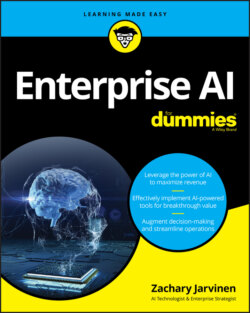Читать книгу Enterprise AI For Dummies - Zachary Jarvinen - Страница 31
Semantic networks and symbolic reasoning
ОглавлениеAlso known as good old-fashioned AI (GOFAI), semantic networks and symbolic reasoning dominated solutions during the first three decades of AI development in the form of rules engines and expert systems.
Semantic networks are a way to organize relationships between words, or more precisely, relationships between concepts as expressed with words, which are gathered to form a specification of the known entities and relationships in the system, also called an ontology.
The is a relationship takes the form “X is a Y” and establishes the basis of a taxonomic hierarchy. For example: A monkey is a primate. A primate is a mammal. A mammal is a vertebrate. A human is a primate. With this information, the system can not only link human with primate, but also with mammal and vertebrate, as it inherits the properties of higher nodes.
However, the meaning of monkey as a verb, as in “don’t monkey with that,” has no relationship to primates, and neither does monkey as an adjective, as in monkey bread, monkey wrench, or monkey tree, which aren’t related to each other either. Now you start to get an inkling of the challenge facing data scientists.
Another relationship, the case relationship, maps out the elements of a sentence based on the verb and the associated subject, object, and recipient, as applicable. Table 1-1 shows a case relationship for the sentence “The boy threw a bone to the dog.”
TABLE 1-1 Case Relationship for a Sentence
| Case | Threw |
| Agent | Boy |
| Object | Bone |
| Recipient | Dog |
The case relationship for other uses of “threw” won’t necessarily follow the same structure.
The pitcher threw the game.
The car threw a rod.
The toddler threw a tantrum.
Early iterations of rules engines and expert systems were code-driven, meaning much of the system was built on manually coded algorithms. Consequently, they were cumbersome to maintain and modify and thus lacked scalability. The availability of big data set the stage for the development of data-driven models. Symbolic AI evolved using the combination of machine-learning ontologies and statistical text mining to get the extra oomph that powers the current AI renaissance.
